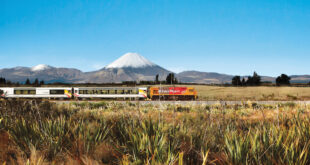You couldn’t get very far talking about Fiordland without the use of superlatives; descriptions such as “the most dramatic…” and “the most beautiful…” abound, while the region boasts New Zealand’s largest National Park , second largest lake and the fourth highest waterfall in the world. Situated on the South Island’s southwest coast, the area is renowned for its breathtaking scenery, native wildlife and captivating walks.
It is almost impossible to imagine how such sharply sculptured fiords, lakes and sounds could have formed. Maori legend claims that the demi-god Tu-te-raki-whanoa carved the fiords out with his adze; in reality, millions of years of glacial activity and some of New Zealand’s harshest weather were responsible for a result that led UNESCO in 1986 to bestow World Heritage status to the region in recognition of its “superlative natural phenomena” and “outstanding examples of the earth’s evolutionary history”.
Doubtful Sound is, indeed, spuriously named: along with Milford Sound, Doubtful Sound is in fact a fiord rather than a sound, and secondly, although the name may suggest otherwise, it is “beyond doubt” among the top destinations in New Zealand – voted the AA’s #2 Must-do for Kiwis , second only to Milford Sound. The name actually originated in 1770, when Capt. James Cook doubted that the winds would be able to carry his boat back out to sea – and thus dared not venture in. These days, access to the fiord is easier, although by boat remains the only way – a 45-50-minute cruise across Lake Manapouri followed by a coach ride across Wilmot Pass.
Milford Sound , by contrast, can be arrived at by air, sea or land. If you choose to drive, the scenery en route to the Sound is well worth the trip, even if you do not intend to hike on the other side. It is an approximate 2-hour drive from Te Anau to Milford Sound, but with plenty of viewpoints and walks along the way, make sure you allow yourself plenty of time. It pays to note that Milford Sound experiences thousands of tourists every year, so you may well meet some traffic in summer, particularly tour buses. Winter and spring, however, bring with them avalanche warnings, and it is a legal requirement that all visitors carry a chain between May and November (these can be hired in Te Anau). For the most part, however, winter in the Sounds means relatively stable weather, with crisp, clear air, stunning snow-capped mountains and less tourist traffic. Whatever the season, be prepared for rain – up to 6m of rain falls in Milford Sound every year, but with the amazing array of waterfalls that really come alive, and haunting, misty ambience, don’t let the wet weather get you down!
If you just don’t think you’re up for the drive, a visit to Doubtful Sound may be more for you. Doubtful Sound, being accessible only by tour, is the more wild and remote of the two Sounds, and thus an ideal place to get away from it all. Some tours pick up from Queenstown and Te Anau, but your best bet is to base yourself in Manapouri and catch a ride across the lake. The landscape in Doubtful Sound is less dramatic than in Milford Sound, but just as beautiful, and there is a slightly larger population of wildlife – dolphins, penguins, seals and a plethora of native birds inhabit the area. Both Sounds offer the possibility of overnight cruises, while walks range from half an hour to half a week one-way. Among the more popular tracks is Milford Track, which takes about 4 days one way, and can be done independently or with the help of a guide. The walk takes in Sutherland Falls, the fourth highest falls in the world, and temperate rainforest.
Hollyford Track is another 4-5 day hike, and is the only track in Fiordland that will take you to the West Coast. Hollyford Track is relatively flat, with no alpine passes, and follows the course of the Fiordland National Park’s longest valley from the Darran Mountains to Martin’s Bay. Here, you can take in resident seal and penguin colonies and magnificent scenery. Along the way, experience waterfalls and views of Mt Madeline and Fiordland’s highest peak, the 2746m Mt Tutoko.
If walking just doesn’t sound daunting enough for you, why not try jet-boating, sky diving or a scenic flight? Of course, the area is stunning even if you’re not up for adventure – or if you simply can’t be bothered on a rainy day. Te Anau is a pleasant township with shops open seven days, restaurants, lakeside cafes, a library, golf course and cinema – what better way to return to civilization after your walk, or simply marvel at the beauty of the area without a backpack on your back? Alternatively, visit the Te Anau Glowworm Caves – a 200m system with waterfalls, whirlpools and a glowworm grotto – or descend a spiral staircase to experience the Milford Deep Underwater Observatory.
Whatever the season, Fiordland offers the most awe-inspiring scenery, the most exhilarating adventure, and nature at its very best – and you’ll need a good thesaurus to find enough superlatives with which to describe it all!
Editorial courtesy of Nicky Shannon from AA Tourism.
Visit aatravel.co.nz to research and book your New Zealand holiday online.








Join the Discussion
Type out your comment here:
You must be logged in to post a comment.